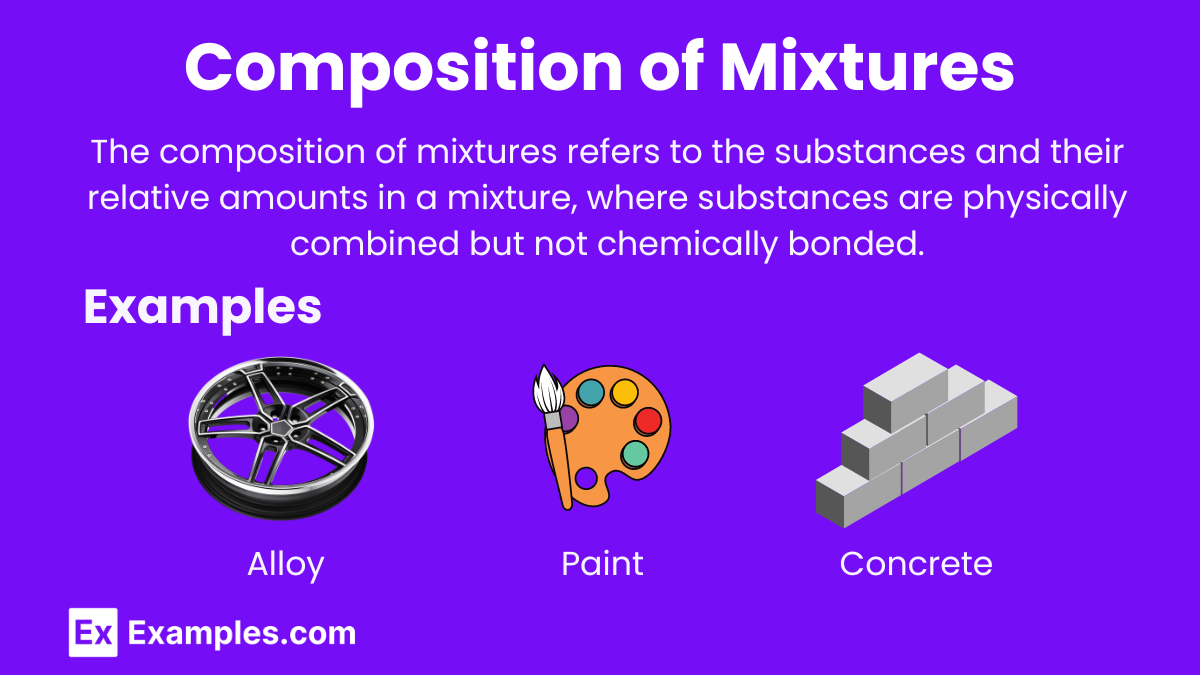Learning Objectives
By the end of this lesson, students will understand the definition and properties of mixtures, differentiate between homogeneous and heterogeneous mixtures, describe methods of separating mixtures, and apply these concepts to solve problems related to the composition of mixtures. This will equip students with the knowledge to answer related questions accurately on the AP Chemistry Exam.
Introduction
The composition of mixtures is a fundamental concept in chemistry, encompassing the study of how different substances combine without chemically reacting to form a single entity. Mixtures can be classified into homogeneous mixtures, where the composition is consistent throughout, and heterogeneous mixtures, where the distinct components are visibly separate. Understanding mixtures involves recognizing their properties, how they differ from pure substances, and the various methods used to separate their components.
What is Composition of Mixtures?
The composition of mixtures refers to the different substances that make up a mixture and the relative amounts of each substance present. Mixtures consist of two or more substances physically combined, but not chemically bonded.
Types of Mixtures
Homogeneous Mixtures
Homogeneous mixtures, also known as solutions, have a uniform composition throughout. In these mixtures, the solute is evenly distributed within the solvent, and the individual components cannot be distinguished.
Examples of Homogeneous Mixtures:
- Salt water: Salt dissolved in water forms a uniform solution.
- Air: A mixture of gases, mainly nitrogen and oxygen.
- Alloys: Mixtures of metals, such as brass (copper and zinc).
Heterogeneous Mixtures
Heterogeneous mixtures have a non-uniform composition with distinct phases or layers. In these mixtures, the different components can be visually distinguished and separated by physical means.
Examples of Heterogeneous Mixtures:
- Salad: Different ingredients like lettuce, tomatoes, and cucumbers are visibly separate.
- Sand in water: Sand particles can be seen and separated by filtration.
- Oil in water: Oil forms distinct droplets on the surface of water.
Properties of Mixtures
- Variable Composition: The proportions of the components can vary.
- Retained Properties: Each component maintains its original properties.
- Physical Combination: Components are physically mixed, not chemically bonded.
- Separation by Physical Means: Methods such as filtration, distillation, and chromatography can separate the components.
- No Fixed Ratios: Components are not combined in fixed ratios.
- Can Be Homogeneous or Heterogeneous: Mixtures can be uniform or non-uniform in composition.
- No Chemical Changes: Mixing does not result in new substances being formed.
Methods of Separation
- Filtration: This technique separates solids from liquids using a porous barrier, such as filter paper. It is effective for heterogeneous mixtures where the solid particles are large enough to be trapped by the filter while the liquid passes through.
- Distillation: This method separates substances based on differences in boiling points. The mixture is heated until one component vaporizes, then the vapor is condensed back into a liquid in a separate container. It is commonly used for homogeneous mixtures.
- Chromatography: This technique separates components based on their movement through a stationary phase (like paper or gel) and a mobile phase (like a solvent). Different substances travel at different speeds, allowing for separation. It is useful for complex mixtures.
- Centrifugation: This method uses centrifugal force to separate substances of different densities. The mixture is spun at high speeds in a centrifuge, causing denser components to move outward and form a separate layer. It’s commonly used for separating blood components.
- Magnetic Separation: This technique uses a magnet to separate magnetic materials from non-magnetic ones. It’s effective for mixtures like iron filings in sand, where the magnetic material can be easily extracted.
- Decantation: This method separates liquids from solids or two immiscible liquids by carefully pouring the top layer into another container, leaving the heavier or sedimented substance behind. It’s useful for separating oil and water.
- Evaporation: This method involves heating a liquid mixture to remove the solvent by converting it to vapor, leaving the solute behind. It’s commonly used to obtain salt from saltwater.
- Sieving: This technique uses a sieve or mesh to separate particles of different sizes. Larger particles remain on the sieve while smaller ones pass through. It’s useful for separating sand from gravel.
Differences Between Homogenous Mixture and Heterogenous Mixture
| Feature | Homogeneous Mixture | Heterogeneous Mixture |
|---|---|---|
| Composition | Uniform | Non-uniform |
| Visibility of Components | Not distinguishable | Distinguishable |
| Phases | Single phase | Multiple phases |
| Distribution of Components | Evenly distributed | Unevenly distributed |
| Separation Techniques | More difficult | Easier |
Examples of Composition of Mixtures
- Alloy: Brass, an alloy of copper and zinc, where the metals are mixed together to enhance properties like strength and corrosion resistance.
- Soil: A complex mixture of organic matter, minerals, gases, liquids, and organisms that together support plant life.
- Concrete: A mixture of cement, sand, gravel, and water, which hardens over time to form a solid building material.
- Milk: A mixture containing water, fats, proteins, lactose, minerals, and vitamins, forming a complex colloidal system.
- Paint: A mixture of pigments, binders, solvents, and additives, blended to create a substance used for coating surfaces.


